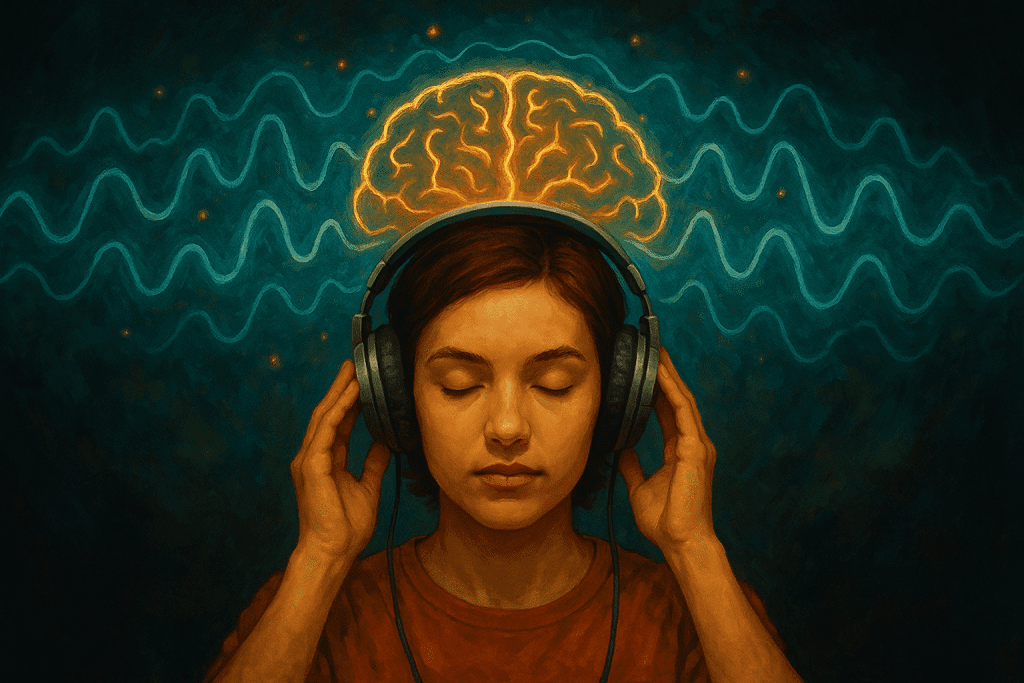
What is Brainwave Entrainment and Can It Improve Focus?
Let’s be honest staying focused today is like trying to meditate on a roller coaster. Notifications ping. Emails pop. Our brains jump from thought to thought like a hyperactive squirrel. But what if you could tune your brain like a radio to a frequency of focus?
Brainwave entrainment techniques, such as light and sound stimulation, are used to achieve enhanced focus by guiding the brain into optimal states for concentration.
That is exactly what brainwave entrainment claims to do.
Let us dive into how this fascinating science might help you channel laser-like focus—even if your brain usually feels like a browser with 37 tabs open.
Introduction to Brainwave Entrainment
What is Brainwave Entrainment?
Brainwave entrainment is the process of using external stimuli, such as sound or light, to synchronize brain activity. Think of it like giving your brain a gentle nudge to get into a more productive rhythm.
There are various brainwave entrainment techniques, which include methods like audio and visual stimulation such as binaural beats, isochronic tones, and rhythmic light pulses to help align your brainwave frequencies with desired mental states.
Brief History and Evolution
The concept is not new. Ancient cultures used rhythmic drumming and chanting as early forms of brainwave entrainment. Today, it is backed by neuroscience and delivered through slick apps, headphones, and frequency generators.
How It Works on a Neurological Level
When exposed to a consistent external rhythm, your brain begins to align its own electrical activity to match. Neural mechanisms, such as the frequency following response, are responsible for how the brain synchronizes its activity with these external rhythms. This process is called frequency following response and it is like your brain catching a beat at a silent disco.
Understanding Brainwaves and Their Role
Types of Brainwaves
Alpha waves and delta waves are commonly targeted in brainwave entrainment for relaxation and sleep.
- Delta (0.5–4 Hz): Deep sleep and unconsciousness. Delta waves are characterized by slow oscillations and are important for deep sleep and relaxation.
- Theta (4–8 Hz): Light sleep, creativity, daydreaming
- Alpha (8–12 Hz): Relaxed, calm, alert but not focused. The alpha rhythm is associated with relaxed, calm, and alert states.
- Beta (12–30 Hz): Active thinking, focus, problem-solving
- Gamma (30–100 Hz): Peak concentration, learning, memory
Which Brainwaves Affect Focus and Attention?
Beta waves are the big players when it comes to focus. Different brainwave states, such as beta and gamma, are associated with varying levels of focus and attention. They are most active when you are alert and mentally engaged. Gamma waves also play a role in high-level cognitive tasks and peak attention.
Methods of Brainwave Entrainment
Binaural Beats
Isochronic Tones
Isochronic beats are a form of brainwave entrainment that use a single tone pulsed on and off at regular intervals. The pulsing sound produced by isochronic beats can be more effective for entrainment than other methods. These are single tones turned on and off rapidly to produce a rhythmic pulse.
Monaural Beats
Two pure tones of different frequencies are combined before reaching the ears to produce monaural beats. They work without headphones but are less effective than isochronic tones.
Visual and Vibrational Stimulation
Visual stimuli, such as flashing light and flickering lights, are commonly used in photic stimulation to influence brain activity. Photic stimulation involves the use of periodic stimuli like flickering lights to entrain brainwaves and induce altered states of consciousness.
The visual cortex processes these visual stimuli and plays a key role in the neurological and subjective effects of light-based entrainment. Some devices utilize synchronized auditory and visual stimuli known as audio visual entrainment combining LEDs and sound to enhance the entrainment effect.
Other senses, such as touch, can also be engaged in brainwave entrainment techniques, providing a multi-sensory approach. Think flashing lights or vibrating devices. Less common but also effective in syncing brainwaves.
Focus and Cognitive Performance
What Is Focus in Neuroscience Terms?
Focus is the brain’s ability to filter out distractions and lock onto a task. It is a tug-of-war between your prefrontal cortex (focus) and limbic system (distraction junkie).
Common Causes of Poor Focus
- Stress
- Sleep deprivation
- Multitasking
- Information overload
- Poor diet or hydration
Why Traditional Methods Often Fall Short
Meditation and mindfulness work but they take time. Supplements may help, but results vary. Brainwave entrainment promises quicker results with less effort.
Traditional methods may not provide all the benefits that brainwave entrainment techniques can offer, especially when it comes to improving focus and mental clarity.
Scientific Evidence Behind Brainwave Entrainment
Studies Supporting Focus Enhancement
- A 2005 study showed that binaural beats improved sustained attention and decreased reaction times.
- A 2018 review found that isochronic tones improved performance in cognitive tasks.
- A 2019 study reported that brainwave entrainment can help reduce stress, in addition to enhancing focus and cognitive performance.
Skeptical Views and Criticisms
Some scientists argue the placebo effect may play a role. Others say more research is needed before declaring it a miracle tool.
Current Limitations in Research
Small sample sizes, inconsistent methods, and lack of long-term studies still leave room for doubt but early results are promising.
How to Use Brainwave Entrainment to Improve Focus
Choosing the Right Frequencies
- Use specific frequencies in the Beta range (13–30 Hz) for optimal concentration
- Alpha (8–12 Hz) if you are feeling overwhelmed and need calm focus
- Some programs combine both for balance
Best Practices for Listening
- Use noise-canceling headphones
- Sit in a quiet place
- Avoid multitasking
- Focus on a single task while listening
Ideal Duration and Timing
Start with 15–30 minutes per session. Best used before or during focused work. Try using it mid-afternoon when your energy dips.
Tools and Apps for Brainwave Entrainment
Popular Apps and Devices
- Brain.fm – AI-curated music for focus
- Binaural Beats Generator – Fully customizable
- Neuroprogrammer 3 – Desktop software
- Mindplace Kasina – Light and sound machine
Free vs Paid Options
Free apps work, but paid versions often offer better sound quality, presets, and deeper customization.
Brainwave Entrainment vs. Other Focus Techniques
Meditation
Meditation rewires your brain over time. Brainwave entrainment can kickstart that state in minutes.
Nootropics
Smart drugs can be effective but come with side effects. Entrainment is non-invasive and natural.
Pomodoro and Time Blocking
Personal Experiences and Testimonials
Real Stories from Users
“I used to need coffee just to open an email. After a week of brainwave entrainment, I can focus for two hours straight.”
“I use binaural beats before coding sprints. It is like putting blinders on my brain. Nothing distracts me.”
What Users Say About Focus Changes
Most report better focus, less mental fatigue, and an easier time entering a “flow” state.
Risks and Considerations
Is It Safe for Everyone?
Generally, yes. But people with epilepsy or neurological conditions should consult a doctor.
Who Should Avoid It?
Those sensitive to sound, prone to migraines, or with a history of seizures should proceed with caution.
Potential Side Effects
Some users report mild dizziness, headaches, or agitation especially if they use the wrong frequency.
Who Can Benefit the Most?
Students
Improve retention, focus during study sessions, and test performance.
Professionals
Helps with productivity, deep work, and creative problem-solving.
ADHD and Neurodivergent Individuals
Integrating It Into Daily Life
Morning Routines
Start your day with 15 minutes of focus-based entrainment instead of scrolling your phone.
During Study or Work Sessions
Play beats during writing, reading, or intense concentration.
Before Bed to Improve Next-Day Focus
Use alpha or theta frequencies to calm the mind and promote restful sleep.
Myths About Brainwave Entrainment
It Works Instantly
You may feel something quickly, but long-term benefits build with consistent use.
It Replaces Sleep or Diet
Nope—this is a tool, not a replacement for good habits.
You Must Use Headphones
Not always. Isochronic tones work without them, but for binaural beats, headphones are a must.
Final Thoughts on Brainwave Entrainment and Focus
Can brainwave entrainment improve focus? The short answer: yes, for many people it does. While it is not a magic bullet, it is one of the few techniques that directly taps into the brain’s electrical language.
Brainwave entrainment works in such a way that it guides the brain into desired states through external stimuli, making it both safe and effective. If you are looking for a safe, science-backed way to upgrade your attention span this might just be your new productivity secret weapon.
FAQs
Some people feel changes in minutes, but lasting focus improvements usually take consistent daily use over a few weeks.
Not always. Binaural beats require headphones, but isochronic tones can be played through speakers.
Yes, but stick to focus-enhancing frequencies and avoid deep relaxation tones unless you are safely seated.
Some studies support its effects, especially on focus and anxiety, but more research is still needed for definitive conclusions.
Yes, but with guidance. It is best used in short sessions and monitored by an adult, especially for younger users.




